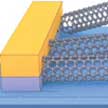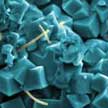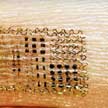Showing Spotlights 73 - 80 of 237 in category All (newest first):
 Mimicking the exciting skin structure and function, researchers have designed hierarchical nanoporous and interlocked micro ridge structured polymers with gradient stiffness. The gradient elastic modulus of interlocked and micro ridge structured polymers effectively transfers the external stress and induces the large frictional contact between two polymeric layers, which facilitates their use in self-powered triboelectric sensors. Furthermore, the additional nanoporous structures in the micro ridge structured polymers lead to the effective variation of both volume and gap distance between opposing surfaces without the need of bulky spacers, resulting in ultrathin and flexible triboelectric sensors for applications in wearable electronics.
Mimicking the exciting skin structure and function, researchers have designed hierarchical nanoporous and interlocked micro ridge structured polymers with gradient stiffness. The gradient elastic modulus of interlocked and micro ridge structured polymers effectively transfers the external stress and induces the large frictional contact between two polymeric layers, which facilitates their use in self-powered triboelectric sensors. Furthermore, the additional nanoporous structures in the micro ridge structured polymers lead to the effective variation of both volume and gap distance between opposing surfaces without the need of bulky spacers, resulting in ultrathin and flexible triboelectric sensors for applications in wearable electronics.
May 22nd, 2018
 Sepsis is the body's extreme response to an infection. It is life-threatening condition in which bacteria or fungi multiply in a patient's blood - often too fast for antibiotics to help. Without timely treatment, sepsis can rapidly cause tissue damage, organ failure, and death. A critical unmet need in combating sepsis is the lack of accurate early biomarkers that can alert clinicians to a potential life-threatening situation and allow them to take preventative action. In a new study, researchers report the development of a point-of-care platform for rapid sepsis detection, called IBS (integrated biosensor for sepsis).
Sepsis is the body's extreme response to an infection. It is life-threatening condition in which bacteria or fungi multiply in a patient's blood - often too fast for antibiotics to help. Without timely treatment, sepsis can rapidly cause tissue damage, organ failure, and death. A critical unmet need in combating sepsis is the lack of accurate early biomarkers that can alert clinicians to a potential life-threatening situation and allow them to take preventative action. In a new study, researchers report the development of a point-of-care platform for rapid sepsis detection, called IBS (integrated biosensor for sepsis).
Apr 12th, 2018
 Over the past few decades, researchers have developed various optical voltage sensing probes in order to overcome the highly invasive nature of electrode-based techniques. These voltage sensing mechanisms can be hampered by some combination of limitations including low sensitivity, slow kinetics, or heavy capacitive loading. This has motivated a group of researchers to explore DNA nanotechnology for developing novel optical voltage sensing nanodevices that convert a local change of electric potential into optical signals.They now report that a voltage can be read out in a nanopore with a dedicated F�rster resonance energy transfer (FRET) sensor on a DNA origami.
Over the past few decades, researchers have developed various optical voltage sensing probes in order to overcome the highly invasive nature of electrode-based techniques. These voltage sensing mechanisms can be hampered by some combination of limitations including low sensitivity, slow kinetics, or heavy capacitive loading. This has motivated a group of researchers to explore DNA nanotechnology for developing novel optical voltage sensing nanodevices that convert a local change of electric potential into optical signals.They now report that a voltage can be read out in a nanopore with a dedicated F�rster resonance energy transfer (FRET) sensor on a DNA origami.
Mar 26th, 2018
 The detection of carbon monoxide (CO) in the air is a vital issue, as CO is a highly toxic gas and an environmental pollutant. Carbon monoxide is poisonous because it blocks the binding site for oxygen in hemoglobin. It is exactly this principle - a porphyrin ring with a central iron or cobalt atom that the poisonous gas attaches to - that can be used to implement sensors to warn against carbon monoxide. While carbon monoxide sensors have been extensively researched and commercialized, none make use of a molecule that can be voltage-activated using a newly reported method.
The detection of carbon monoxide (CO) in the air is a vital issue, as CO is a highly toxic gas and an environmental pollutant. Carbon monoxide is poisonous because it blocks the binding site for oxygen in hemoglobin. It is exactly this principle - a porphyrin ring with a central iron or cobalt atom that the poisonous gas attaches to - that can be used to implement sensors to warn against carbon monoxide. While carbon monoxide sensors have been extensively researched and commercialized, none make use of a molecule that can be voltage-activated using a newly reported method.
Dec 20th, 2017
 Moderate exposure to sunlight has significant health benefits, however, exposure to ultraviolet (UV) radiation also is a major risk factor for most skin cancers. That means that, while moderate exposure to sunlight is recommended, there is a fine line to walk between beneficial and harmful amounts of UV exposure. To take the guesswork out of assessing the exposure to damaging UV rays, several wearable consumer UV sensors have already hit the market. Researchers have now proposed a simple and low-cost stick-on nanoplasmonic patch made of optically active silver nanoparticles embedded in a film of nanopaper. The patch changes color once it has been exposed to a certain amount of UV light.
Moderate exposure to sunlight has significant health benefits, however, exposure to ultraviolet (UV) radiation also is a major risk factor for most skin cancers. That means that, while moderate exposure to sunlight is recommended, there is a fine line to walk between beneficial and harmful amounts of UV exposure. To take the guesswork out of assessing the exposure to damaging UV rays, several wearable consumer UV sensors have already hit the market. Researchers have now proposed a simple and low-cost stick-on nanoplasmonic patch made of optically active silver nanoparticles embedded in a film of nanopaper. The patch changes color once it has been exposed to a certain amount of UV light.
Nov 22nd, 2017
 Metal-organic frameworks (MOFs) are well-ordered, lattice-like crystals. The nodes of the lattices are metals, which are connected by organic molecules. Their size-controllable nanopores, special structure and large surface area make MOFs very attractive materials for next-generation, highly sensitive gas sensors. In new work, researchers demonstrate a process that can be used for developing low-cost and highly sensitive gas sensors. By increasing the sensitivity, the amount of gas sensitive material and device size can be reduced which in turn would reduce the overall cost of the device and energy consumption.
Metal-organic frameworks (MOFs) are well-ordered, lattice-like crystals. The nodes of the lattices are metals, which are connected by organic molecules. Their size-controllable nanopores, special structure and large surface area make MOFs very attractive materials for next-generation, highly sensitive gas sensors. In new work, researchers demonstrate a process that can be used for developing low-cost and highly sensitive gas sensors. By increasing the sensitivity, the amount of gas sensitive material and device size can be reduced which in turn would reduce the overall cost of the device and energy consumption.
Nov 7th, 2017
 Nanotechnology materials are going to open new realms of possibility for flexible and stretchable monitoring gadgets that are wearable directly on the skin. Here we look at the latest developments in a class of electronic devices, commonly referred to as electronic skin, epidermal electronics, or electronic tattoos, from the materials, devices, and medical applications perspectives. While such devices can also be used for prosthetics and rehabilitation, optogenetics, and human-machine interfaces, this review focuses on the properties of the materials that enable skin-mounted sensors for use as diagnostic tools in the medical field.
Nanotechnology materials are going to open new realms of possibility for flexible and stretchable monitoring gadgets that are wearable directly on the skin. Here we look at the latest developments in a class of electronic devices, commonly referred to as electronic skin, epidermal electronics, or electronic tattoos, from the materials, devices, and medical applications perspectives. While such devices can also be used for prosthetics and rehabilitation, optogenetics, and human-machine interfaces, this review focuses on the properties of the materials that enable skin-mounted sensors for use as diagnostic tools in the medical field.
Sep 26th, 2017
 The incidence of food allergies, food sensitivities, and autoimmune reaction is increasing worldwide, particularly among children. Designing a novel device for food testing, researchers have developed a portable, point-of-use technology for rapid, integrated exogenous antigen testing (iEAT). The system consists of a disposable allergen extraction device and an electronic keychain reader for sensing and communication. The extraction kit captures and concentrates food antigens from dispersed food. Captured allergens are then quantified using the miniaturized key-chain reader.
The incidence of food allergies, food sensitivities, and autoimmune reaction is increasing worldwide, particularly among children. Designing a novel device for food testing, researchers have developed a portable, point-of-use technology for rapid, integrated exogenous antigen testing (iEAT). The system consists of a disposable allergen extraction device and an electronic keychain reader for sensing and communication. The extraction kit captures and concentrates food antigens from dispersed food. Captured allergens are then quantified using the miniaturized key-chain reader.
Sep 6th, 2017
 Mimicking the exciting skin structure and function, researchers have designed hierarchical nanoporous and interlocked micro ridge structured polymers with gradient stiffness. The gradient elastic modulus of interlocked and micro ridge structured polymers effectively transfers the external stress and induces the large frictional contact between two polymeric layers, which facilitates their use in self-powered triboelectric sensors. Furthermore, the additional nanoporous structures in the micro ridge structured polymers lead to the effective variation of both volume and gap distance between opposing surfaces without the need of bulky spacers, resulting in ultrathin and flexible triboelectric sensors for applications in wearable electronics.
Mimicking the exciting skin structure and function, researchers have designed hierarchical nanoporous and interlocked micro ridge structured polymers with gradient stiffness. The gradient elastic modulus of interlocked and micro ridge structured polymers effectively transfers the external stress and induces the large frictional contact between two polymeric layers, which facilitates their use in self-powered triboelectric sensors. Furthermore, the additional nanoporous structures in the micro ridge structured polymers lead to the effective variation of both volume and gap distance between opposing surfaces without the need of bulky spacers, resulting in ultrathin and flexible triboelectric sensors for applications in wearable electronics.
 Subscribe to our Nanotechnology Spotlight feed
Subscribe to our Nanotechnology Spotlight feed





